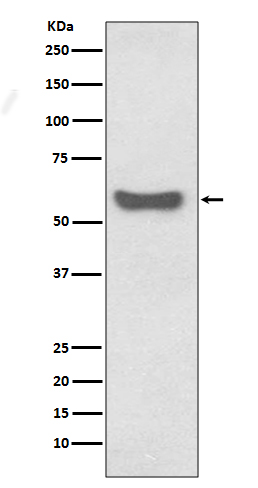
| WB | 1/500-1/1000 | Human,Mouse,Rat |
| IF | 1/20 | Human,Mouse,Rat |
| IHC | 1/50-1/100 | Human,Mouse,Rat |
| ICC | 1/50-1/200 | Human,Mouse,Rat |
| FCM | 咨询技术 | Human,Mouse,Rat |
| Elisa | 咨询技术 | Human,Mouse,Rat |
| Aliases | IGHA1; Ig alpha-1 chain C region; IGHA2; Ig alpha-2 chain C region |
| Entrez GeneID | 3493/3494 |
| WB Predicted band size | Calculated MW: 60 kDa; Observed MW: 60 kDa |
| Host/Isotype | Rabbit IgG |
| Antibody Type | Primary antibody |
| Storage | Store at 4°C short term. Aliquot and store at -20°C long term. Avoid freeze/thaw cycles. |
| Species Reactivity | Human |
| Immunogen | A synthesized peptide derived from human IgA |
| Formulation | Purified antibody in PBS with 0.05% sodium azide. |
+ +
以下是关于人类IgA抗体的3篇代表性文献及其摘要概括:
1. **文献名称**: "Regulation of IgA class switching"
**作者**: Stavnezer, J., & Schjerven, H.
**摘要**: 该综述系统总结了IgA抗体类别转换重组(class switch recombination, CSR)的分子机制,探讨了细胞因子(如TGF-β)和转录因子(如NF-κB)在黏膜B细胞分化为IgA浆细胞中的作用。
2. **文献名称**: "The biology of IgA and IgA deficiency in human health and disease"
**作者**: Furtado, P. B., et al.
**摘要**: 本文分析了IgA的结构特征及其在黏膜免疫中的核心功能,讨论了IgA缺乏症与反复感染、自身免疫疾病的关系,并提出IgA在维持肠道菌群平衡中的潜在机制。
3. **文献名称**: "Human IgA binds a diverse array of commensal bacteria"
**作者**: Pabst, O., & Pilette, C.
**摘要**: 研究通过高通量测序和流式细胞术揭示,人类分泌型IgA(sIgA)能够广泛识别并包裹肠道共生菌群,通过“免疫排斥”机制限制病原体定植,同时维持肠道稳态。
4. **文献名称**: "Therapeutic applications of IgA antibodies in infectious diseases"
**作者**: Bettler, B., et al.
**摘要**: 探讨了IgA抗体在抗病毒(如流感、HIV)和抗细菌感染中的治疗潜力,强调其通过中和病原体及阻断上皮黏附的功能,并展望了工程化IgA药物的开发前景。
以上文献涵盖了IgA的分子机制、生理功能、疾病关联及治疗应用,均为领域内经典或前沿研究。
Human immunoglobulin A (IgA) is a critical component of the mucosal immune system, serving as the predominant antibody class in secretions such as saliva, tears, breast milk, and respiratory/gastrointestinal mucosae. It exists in two primary forms: monomeric IgA in serum (10-15% of circulating antibodies) and polymeric secretory IgA (sIgA) in mucosal secretions. IgA is produced by plasma cells in mucosal-associated lymphoid tissues (MALT) and consists of two heavy (α) and two light chains, forming dimers or trimers stabilized by a J-chain. Secretory component, derived from the polymeric immunoglobulin receptor (pIgR), protects sIgA from proteolytic degradation in mucosal environments.
Functionally, IgA neutralizes pathogens, blocks microbial adhesion to epithelial surfaces, and facilitates antigen removal via "immune exclusion." It engages with mucosal pathogens while maintaining tolerance to commensal microbiota. Two subclasses exist: IgA1. dominant in serum and upper mucosal sites, and IgA2. enriched in the lower gastrointestinal tract and resistant to bacterial proteases. IgA also interacts with Fcα receptors (FcαRI) on immune cells to modulate inflammatory responses. Its non-inflammatory nature makes it crucial for homeostasis at barrier surfaces. Deficiencies in IgA are linked to increased mucosal infections, allergies, and autoimmune conditions, underscoring its vital role in immune defense and regulation.
×